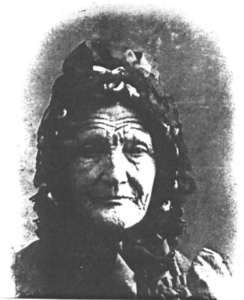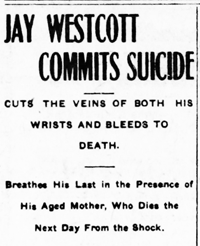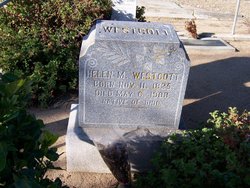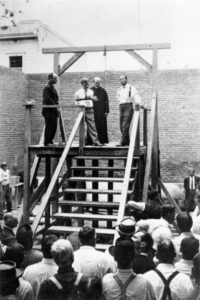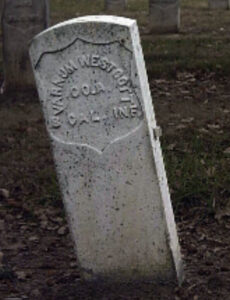Note: This is a long page as it contains three complete newspaper accounts of the exploits of Varnum Westcott. If you already know the story of Varnum’s 1900 expedition to Alaska, you can skip to sections added to this page on February 21, 2021:
• More on Varnum and Helen Westcott
• Just a Miner for a Heart of Gold, leap-year engagement to Lizzie Shaver
• Electa Hawkins Gets Her Man; Arizona Authorities Get Theirs, Varnum’s second marriage
• The Cozy Little Home at Eleventh and Ohio Streets, Varnum’s final years
Corrections and additions are always welcome. — David Wescott Smith, SSWDA Historian
Varnum and Helen Westcott were both 75 years old when they boarded the steamship Zealandia bound for Nome, Alaska. Varnum (1825-1912) was a descendant of Stukely and Juliana Westcott in the eighth generation: Varnum W. Westcott8, David7, Ephraim6, Oliver5, George4, Jeremiah Jr3, Jeremiah2, Stukely1. The Westcotts were setting out to hunt for gold, as told in the Tuesday, May 22, 1900 edition of The San Francisco Call:
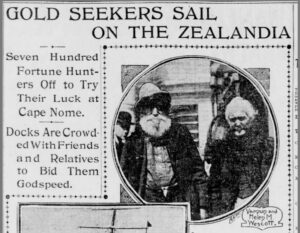
“Varnum and Helen Westcott were the most interesting passengers boarding the Zealandia.” Click the image to display the full page.
Gold Seekers Sail on the Zealandia
Seven Hundred Fortune Hunters Off to Try Their Luck at Cape Nome.
Docks Are Crowded With Friends and Relatives to Bid Them Godspeed.Something like the scenes when the first army transports were sailing, soldier laden, for the Philippines, was that of yesterday afternoon at the Pacific dock when the steamship Zealandia puffed out for Nome fairly alive with excited humanity, all her flags flying and her whistles blowing a shrill good-bye in response to the various cries and hat and handkerchief waving of the thousands of men, women and children, relatives, friends and curious, gathered on the dock from which she sailed and the Broadway dock, opposite. Laughter, tears, sobs and cheers expressed the various emotions of those in the throng.
This, the largest steamer thus far sent to Nome, carried the largest number of people that yet has gone at one time. There were 750 passengers and a crew of 120 on board, 870 souls in all. In the crowd gay youth and hoary old age brushed together. Many women were aboard, most of them going without male protection to seek their fortunes in the greatest mining camp of all times.
The dock from which the Zealandia sailed would have been so jammed with spectators that the passengers would have found it almost impossible to get aboard had not entrance been restricted. The overflow filled the space on the seawall, and the Broadway dock carried a large throng.
Gets Away on Time
Assistant Superintendent L.A. Phillips of the Alaska Exploration Company, under whose flag the steamer sailed, and the company’s secretary, S.W. Saalburg, were there to superintend the departure of the vessel. She got away at 3:15 p.m. only a quarter of an hour later than the schedule time. Several passengers came near getting left. One belated passenger was rowed out to the ship just as she backed into the stream and was hauled aboard.The most interesting passengers on the ship were an aged couple, pioneers of California. They were going to Alaska to “begin life anew,” as the snowy-headed husband put it. Varun [sic] Westcott, 75 years of age, of Soledad, and Helen M. Westcott, his wife, also 75, found their way, hand clapped in hand, through the dense crowd and on to the ship, where they seemed to take all the eager interest exhibited by younger people in the getting away of the ship.
“I’m going up there to mine,” said the old man, his eyes bright with expectancy. “I mined in California in ’49 and I haven’t forgotten how. We’ve got as complete an outfit as anybody going up.”
“We want to be where the excitement is,” piped the old lady, “and that’s why we’re going up there.”
Has a Political Mission
Edward McGettigan, formerly a member of the Democratic State Central Committee, for years in control of the Mare Island Navy yard and known among politicians from one end of California to the other, was one of the passengers, his son Lewis accompanying him. Mr. McGettigan goes as the representative of the wholesale liquor house which he has represented for years, but it is said he has another mission, which is to aid in fulfilling the political aspirations of his friend, Tom Geary of Santa Rosa. The ex-Congressman sailed nearly two weeks ago for Nome, and it is said that in addition to a desire to make money practicing law there he has an ambition to represent the greater Alaska in the National House of Representatives. Campaigning in Alaska, where it sometimes takes a month or more to go from one principle town to another, will be quite a different thing from what it is here, and the office-seeker will be puzzled as to where to begin and where end.H.L. Byrne, the capitalist, and Charles Watson of the Standard Oil Company went along, the former to invest in mines, the latter to represent his company. Phil Howell, the bookmaker; Sam Dannenbaum and Mose Selig formed part of the crowd that left on the ship. Howell took along a big portable house with ten auxiliaries and will start a general sporting resort there. Dannebaum and Selig will embark in the cigar business. The pair sat on a lifeboat as the ship pulled out and drank to their friends from a bottle of champagne. Dannenbaum waving an American flag the while.
Captain I.N. Hibbard, general superintendent for the A. E. Company; H.A. Brigham, superintendent of the mining department, and W.H. Dohrmann, its chief accountant at St. Michael, sailed on the Zealandia.
Woman Passenger Faints
The excitement and close atmosphere on the deck overcame Mrs. Rosenberg, who goes to Nome to start a swell restaurant, and a few minutes before the boat pulled out, she fell in a faint amidst a party of friends on the dock. They immediately tried to revive her, and though she soon regained consciousness she seemed in a sort of stupor and unaware of what was going on around her.“Look here,” exclaimed Assistant Superintendent Phillips, tapping her on the shoulder. “Do you know this boat leaves in three minutes and that if you don’t get aboard you won’t get to Nome?”
Consciousness of her enterprise seemed to rush suddenly back to Mrs. Rosenberg at these words. She sprang to her feet, brushed the hair from her eyes and dashed up the gangplank before her friends could even shake hands with her. When the steamer pulled out, she stood at the rail on the hurricane deck waiving her handkerchief and smiling.
Vincent Hook, formerly Sheriff of Contra Costa County, and Mitchell Phillips of San Jose, at one time chief stevedore for the Pacific Mail Steamship Company in this city, were also among the passengers. Hook has claims at Nome, and Phillips represents a mining and trading company for which 200 tons of machinery were shipped on another boat. He took seven men with him.
Chinese Cooks Left Behind
Twenty-eight Chinese cooks employed by the company were at the dock ready to sail, but they did not get away. They refused to submit to vaccination ordered by the Health Board and were not allowed to go aboard. These men were employed at $65 a month each. The company would have preferred white cooks at even better wages, but white men cannot be depended on because they quit work and rush to the scene of every new mining excitement, leaving the company in the lurch. Another force of cooks will be secured and sent up on the Humbeoldt Wednesday week.Ex-Superior Judge Ansel Smith and J.B. McNamara, a sporting man of Stockton, sailed with the crowd. Mrs. Polsky and her daughter of the same town went on the Zealandia to seek fortune in Nome. Jon Dearin of O’Donnell & Dearin, the Grant-avenue saloon men, went along, as did Billy Fitzgerald, the politician, who will probably start a pure-politics club in Nome with a picture of Chris Buckley over the door as a source of inspiration.
More on Varnum and Helen Westcott
The Alaska foray was but the latest adventure for Varnum Westcott, sea captain, successful prospector and wealthy landowner. From public records and newspaper accounts, influenced by his ability to tell a good tale, we learned that Varnum Westcott:
- Commanded a voyage of the bark Sena “around the Horn” to join the 1849 Gold Rush
- Captained a steamship for 20 years and twice circled the globe
- Mined for precious metals throughout the West
- Owned 1,000 acres in Ranch San Andreas (where he survived poisoning by a ranch hand)
- Was in serious debt and regained his wealth at least once
- Contracted to deliver 60,000 pounds of barley to the Fort Miller during the Mariposa Indian War (1850-1851)
- Enlisted on November 1, 1864 ( at the age of 39) in the Union Army, serving with Company A of the California 8th Infantry Regiment.
Varnum Westcott married Helen Mariah Robinson sometime prior to the Civil War when the two were both in their mid-twenties. Helen Mariah Robinson was born on November 11, 1825 in Onodaga County, New York to Steven Van Renseler Robinson and Emeline (Haynes) Robinson. She was two years old when the family moved to Huron County, Ohio.
According to the 1880 U.S. census, sea captain Varnum Westcott and his wife Helen, both 54, were living in Pajaro township in Santa Cruz with their three children. Their daughter Belle was 20 years old that year and married to Robert J. Fulton, a farmer aged 25 years. Son Bey, aged 18 years, was single, also working as a farmer. Younger son Jay was 13.
Helen and Varnum separated sometime after their return from Alaska. In 1908, she was living in Creston, California with her son Jay, who suffered from tuberculosis. On May 5, 1908, Jay slit his wrists. Helen discovered him bleeding out and she died of the shock the following day. She is buried at Soledad Cemetery, Monterey County, California.
On January 3, 1896 Bey Westcott, a “substantial businessman” in Soledad, married Mary Smith of Cincinnati. Bey was a prominent citizen in the Salinas Valley, lauded by the Salinas Californian in 1909 for improving the water supply of the area and later noted for his cooking skills for a local Druids chapter. But wait! There’s more.
Just a Miner for a Heart of Gold
Varnum Westcott continued to make news after he and Helen returned from their profitable trip to Nome, as he became engaged in 1904, and then again in 1909, each time to a woman sixty years his junior. The first was reported on the front page above the fold in the February 24 Santa Cruz Evening Sentinel, with the headline and lead focusing on this “leap year proposal:”
GIRL PROPOSED TO WATSONVILLE MAN
STOCKTON, Feb. 22 – Lizzie Shaver, a pretty young woman of this city, 21 year old, took advantage of the leap year Monday to propose to Vernum {sic} Westcott , a resident of Watsonville, aged 60, and reported to be wealthy.Westcott, who is white-haired and looks to be nearer 80 than 60, appealed to a policeman to assist him in finding the County Clerk, it being a holiday. When Westcott found County Clerk E.D. Graham, he confided to the official that he had accepted a leap year proposal and wanted a marriage license. Westcott said he had come to Stockton on a visit, had met Miss Shaver, whom he regarded more as a granddaughter than as a prospective wife. Miss Shaver came and sat beside him last evening and said: “You’re an awful nice old man. I like you ever so much. Have you ever had any thoughts of marrying?”
Westcott replied, laughing, “Why, you wouldn’t marry an old fellow like me would you”? Miss Shaver replied that she would marry him if he would have her. Westcott accepted the proposal, and set the date of their wedding for Monday. He said he was sure that Miss Shaver did not propose to him for his money but that it was a case of love at first sight. He said his bride to be was getting her trousseau ready while he was getting the license. He offered a $10 piece in payment for the license and demanded that Graham keep the change.
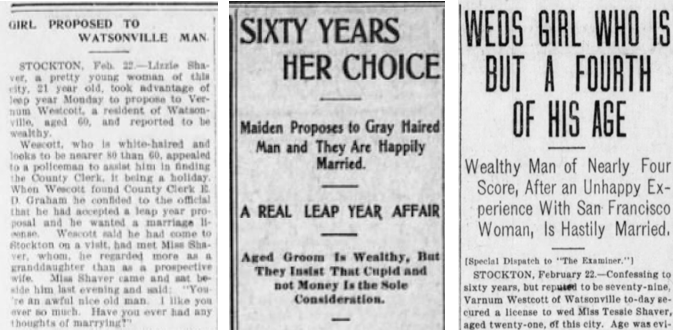
Headlines in the Santa Cruz Sentinel, Morning Astorian and San Francisco Examiner give progressively more details about Lizzie Shaver’s proposal to Varnum Westcott
The story of Lizzie Shaver’s proposal was picked up two days later by the Morning Astorian in Astoria, Oregon, with the Stockton dateline and the comment, “The young bride is a sister of a local clairvoyant and is well known here.” The editors probably ran the story because Captain Westcott would have been a known quantity in the port of Astoria. But it was the San Francisco Examiner that on February 23, 1904 supplied story behind the story:
It appears that Miss Shaver would not have had her golden opportunity of proposing had other affairs of the heart not turned out as they did. Notwithstanding his weight of years, this old man from Watsonville has had other flutterings of the heart and a few weeks ago he thought he was to have Miss Minnie Williams, a young woman whom he met at the home of Mrs. Leroy in San Francisco, for his bride. Some weeks ago Westcott elected to have some recreation in San Francisco and chanced to meet Mrs. Leroy, formerly a neighbor of his near Watsonville, but now a clairvoyant.
MONEY-SEEKING LETTERS.
When he returned home be received letters from Mrs. Leroy and with them were letters bearing the signature of Miss Williams. These letters conveyed greetings of love and the old man was highly pleased. She assured him that she was going to him to make his last years pleasant, for love’s own sweet sake. One day he received a letter from her to the effect that she had run a nail into her foot and needed some financial aid. Of course the money was sent her. Next came the information that blood poison had developed. This meant more money. At the proper time he received a letter that Miss Williams was dead, it undoubtedly being thought that he would forward enough money for the funeral expenses. This he failed to do, however, and so it was found expedient to resurrect the young lady. She wrote him a pathetic note stating that she about well, but she needed $30 to settle her expenses. As soon as the money was received she would hasten to him and remain with him always. About this time. however, some acquaintance of Westcott learned of his love affair and convinced him that the woman was making a fool of him.The handwriting of letters signed by Mrs. Leroy and Miss Williams was compared and quite similar. For the present, however, Westcott is quite happy in possession of the fair young lady of this city.
It appears that the wedding of Varnum Westcott and Lizzie Shaver never took place. Maybe word that Varnum was still married caused the county clerk to put a stop to it all or prompted Lizzie to walk away. It’s equally possible that the 79-year-old Westcott was just being pranked. When Lizzie did marry, it was to 30-year-old Fred Fischer in Elko, Nevada in January 1906. But wait. There’s more!
Electa Hawkins Gets Her Man, Arizona Authorities Get Theirs
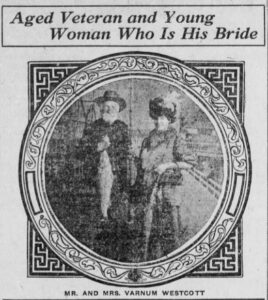
Varnum Westcot and Electa Hawkins, each with a fresh catch, in a photo accompanying their story in the March 10, 1909 edition of the Los Angeles Herald
Five years later, and two years after the death of Helen Westcott, the Los Angeles Herald broke the story of another twenty-something prompting Westcott to purchase a marriage license. The suspected gold-digger was Mrs. Electa Bessie Hawkins and this time they were actually married, in a ceremony witnessed by Electa’s father E.C. Chase, who was Varnum’s fellow “inmate” at the National Home for Volunteer Soldiers, Pacific Branch in the Sawtelle area of L.A.
The report supplied some details of “aged veteran’s” life of adventure, but was silent on how this Mrs. Hawkins was eligible to marry Varnum other than that she was 21 years old. This answer came six days later in the Bisbee (Arizona) Daily Review, which reran the Herald story almost verbatim and then explained that Electa was widowed when her husband was executed on August 14, 1908, in the last legal hanging in Tucson.
Here is the Daily Review’s account:
VETERAN, AGE EIGHTY-THREE, WEDS MAIDEN
Romantic Love Affair Terminates In Soldiers Home at
Sawtelle, California—Bride Is Only Twenty-OneTUCSON, March 15 — A wedding which took place at Sawtelle, California, March 9, the parties to the affair being Electa Bessie Hawkins and Varnum Westcott, an inmate of the Soldiers’ Home at the place. The bride gave her age as 21 and the groom announced his to be 83 when the marriage took place before Recorder Walter Downs of Sawtelle.
For several years the aged veteran of the civil war had courted the pretty woman. Although nearly four times the age of his bride, Westcott is exceedingly active and enjoys robust health. He was “before the mast” for 20 years, having commanded the bark Sena, in which he rounded the Horn in 1849. Like his bride, Westcott has been married before.
Mrs. Hawkins is a daughter of C. E. Chase, also an inmate of the Soldiers’ Home. Chase at one time was one of the most prominent mining men in Arizona, but lost his money several years ago. Westcott and Chase have been ward mates at the Soldiers’ Home. Chase’s daughter and Westcott met, however, several years ago.
It was love at first sight on the part of the aged veteran and the love was returned by Mrs. Hawkins, who was barely more than 18 years old at the time. Marveling at the former soldier’s remarkable history, which she learned from various sources, Mrs. Hawkins decided he was the man who should be her husband.
Westcott’s life has been filled with stirring incidents and many stories of his bravery in battle against the Indians, in the civil war and on the seas, were told her by her friends and by Westcott. The wedding came as a great surprise to Captain Smith, who is in charge of the barracks where Westcott was quartered. Even his closest associates were uninformed of his intention to marry. Westcott has been in the Soldiers’ Home hardly a month. During that time he has visited the woman of his choice daily. It was the general impression around the barracks that she was his daughter and the soldiers were taken by complete surprise when they learned that the two were sweethearts and had been married.
Two days prior to the wedding Westcott bought a cozy little home at Eleventh and Ohio streets, Sawtelle. He will live there with his bride just as soon as he can make arrangements to leave the home. He secured an eight-day leave of absence following his marriage, so that he could take his bride on a honeymoon.
Besides being a soldier, Westcott is a traveler and a pioneer. He came to California at the time of the gold excitement. At one time he owned a thousand acres of the famous San Andres ranch in Santa Cruz county. He has encircled the globe twice. In 1898 he went up to Alaska, although well on in years. He prospected with considerable good fortune and is comfortably fixed. His marriage to Mrs. Hawkins developed the fact that the bride’s father had a son-in-law old enough to be his own father.
Electa’s first husband, D.W. Hawkins, confessed to murder and several other crimes and was hung on August 10, 1908 in Tucson.
Electa Bessie Chase will be remembered quite well as the wife of D. W. Hawkins, who, with his wife, were implicated in the murder of Albert Leonhardt on East Alameda street late one night in December, 1907. The murder was a mysterious affair and it was not until several months later that the truth became known.
Hawkins, who had been a conductor on the Tucson Rapid Transit line, and his wife were arrested on charge of burglary. During their confinement in jail Hawkins, backed by his wife, confessed to the murder of Leonhardt, implicating one Earl Metzler, who had also been a conductor on the same road, with complicity in the crime. Metzler had gone to California, where he was arrested and brought back to Tucson and held for trial. Hawkins told a number of sensational stories of his life, before and after the trial. The plea of guilty on his part ended in his being sentenced to be hung. The wife was given her freedom in view of her condition, becoming a mother prior to the trials, which were postponed several times.
The hanging of Hawkins, who admitted his many crimes, and gave his age at 22 years while in jail, in one of the interviews accorded a reporter, took place in the jail yard last August in the presence of a large number of persons, admitted by invitation and many small boys and others from points of vantage on the court house roof and other roofs overlooking the yard. Hawkins was the coolest person in the whole crowd and smoked, talked and sang while on the scaffold. The scene was photographed and boys sold these. The whole affair from date of the murder until the end of the scene in the jail yard was one of the most sensational on record in Pima county, even in Arizona.
The widow and her child were provided with transportation and they left before the hanging for Chicago to make their home with the parents of Hawkins. Later Mrs. Hawkins drifted to Sawtelle, and the outcome is given above. The father of Bessie Chase left here over a year ago to become an inmate of the home. He had been an engineer at the city water works and the university in recent years. His wife was left here and has been seen about the city since her husband’s departure. During the incarceration of Hawkins the mother associated with Bessie, who was kept in jail but a short time.
The Cozy Little Home at Eleventh and Ohio Streets
But wait. There’s more, at least according to the February 7, 1910 Pomona (California) Daily Review:
FATHER AT 83; MOTHER 28
Stork Leaves Baby Girl at Home of Civil War Veteran
SAWTELLE, Feb. 7 — The stork today left a baby girl at the home of Mr. and Mrs. Vernum {sic} Westcott, aged, respectively 83 and 28 years. The father is a veteran of the Civil War and has been a resident of Sawtelle for several years. He owns a pretty home at Eleventh Street and Oregon Avenue. Mrs. Westcott until one year ago was Mrs. Buelah Hawkins. They were married by City Recorder Downs of Sawtelle.
In less than a year, Varnum became Vernum, Electa Bessie aged seven years and became Beulah, and a baby girl showed up at the house that moved from Ohio Street to Oregon Avenue. Perhaps we cannot rely on this notice to prove paternity.
On May 13, 1909, Varnum Westcott checked back in at the Soldiers Home and was there for the 1910 federal census the following May, which lists the 84-year-old veteran had been married twice, the second time for one year. On May 23, he was one of 56 inmates eligible for an honorable discharge because they were financially able to support themselves. According to the Soldiers Home records, Varnum, whose disabilities included “senility,” was discharged on September 21, 1911, to join his daughter Belle Fulton in Soledad or transfer to the Soldiers Home of California in Yountville. He died on July 30, 1912 and is buried in the veterans cemetery in Yountville.
Sources:
Ancestry.com, 1880 and 1910 federal census
Arizona Daily Star. “Tales from the Morgue” for photo of Hawkins execution and the Bisbee Daily Review article
Edna Lewis, The Westcott Family Tree, 1999 (see number 649)
National Park Service, “National Register of Historical Places: Lyons, Harrison Homestead Historic District
Robert Nelson, “WESTCOTT, VARNUM (1831 – 1912),” Old Soldier: the story of the Grand Army of the Republic in Santa Cruz County. Santa Cruz, CA: The Museum of Art & History, (c) 2004. SCPL Local History
“Newspapers Articles about Varnum Westcott” (19-page PDF) compiled from Newspapers.com by Lynn Hulkow

